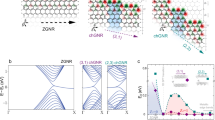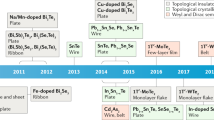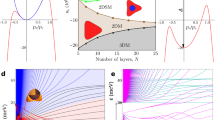Abstract
Boundaries between distinct topological phases of matter support robust, yet exotic quantum states such as spin–momentum locked transport channels or Majorana fermions1,2,3. The idea of using such states in spintronic devices or as qubits in quantum information technology is a strong driver of current research in condensed matter physics4,5,6. The topological properties of quantum states have helped to explain the conductivity of doped trans-polyacetylene in terms of dispersionless soliton states7,8,9. In their seminal paper, Su, Schrieffer and Heeger (SSH) described these exotic quantum states using a one-dimensional tight-binding model10,11. Because the SSH model describes chiral topological insulators, charge fractionalization and spin–charge separation in one dimension, numerous efforts have been made to realize the SSH Hamiltonian in cold-atom, photonic and acoustic experimental configurations12,13,14. It is, however, desirable to rationally engineer topological electronic phases into stable and processable materials to exploit the corresponding quantum states. Here we present a flexible strategy based on atomically precise graphene nanoribbons to design robust nanomaterials exhibiting the valence electronic structures described by the SSH Hamiltonian15,16,17. We demonstrate the controlled periodic coupling of topological boundary states18 at junctions of graphene nanoribbons with armchair edges to create quasi-one-dimensional trivial and non-trivial electronic quantum phases. This strategy has the potential to tune the bandwidth of the topological electronic bands close to the energy scale of proximity-induced spin–orbit coupling19 or superconductivity20, and may allow the realization of Kitaev-like Hamiltonians3 and Majorana-type end states21.
This is a preview of subscription content, access via your institution
Access options
Access Nature and 54 other Nature Portfolio journals
Get Nature+, our best-value online-access subscription
$29.99 / 30 days
cancel any time
Subscribe to this journal
Receive 51 print issues and online access
$199.00 per year
only $3.90 per issue
Buy this article
- Purchase on Springer Link
- Instant access to full article PDF
Prices may be subject to local taxes which are calculated during checkout




Similar content being viewed by others
References
Hasan, M. Z. & Kane, C. L. Topological insulators. Rev. Mod. Phys. 82, 3045–3067 (2010).
König, M. et al. Quantum spin Hall insulator state in HgTe quantum wells. Science 318, 766–770 (2007).
Kitaev, G. Unpaired Majorana fermions in quantum wires. Phys. Usp. 44, 131–136 (2001).
Bradlyn, B. et al. Topological quantum chemistry. Nature 547, 298–305 (2017).
de Vries, E. K. et al. Towards the understanding of the origin of charge-current-induced spin voltage signals in the topological insulator Bi2Se3. Phys. Rev. B 92, 201102 (2015).
Mourik, V. et al. Signatures of Majorana fermions in hybrid superconductor-semiconductor nanowire devices. Science 336, 1003–1007 (2012).
Chiang, C. K. et al. Electrical conductivity in doped polyacetylene. Phys. Rev. Lett. 39, 1098 (1977).
Su, W.-P., Schrieffer, J. R. & Heeger, A. J. Soliton excitations in polyacetylene. Phys. Rev. B 22, 2099–2111 (1980).
Longuet-Higgins, H. C. & Salem, F. R. S. L. The alternation of bond lengths in long conjugated chain molecules. Proc. R. Soc. Lond. A 251, 172–183 (1959).
Su, W., Schrieffer, J. R. & Heeger, A. J. Solitons in polyacetylene. Phys. Rev. Lett. 42, 1698 (1979).
Asbóth, J. K., Oroszlány, L. & Pályi, O. A short course on topological insulators: band-structure topology and edge states in one and two dimensions Lecture Notes in Physics Vol. 919 (Springer, Cham, 2016).
Meier, E. J., An, F. A. & Gadway, B. Observation of the topological soliton state in the Su–Schrieffer–Heeger model. Nat. Commun. 7, 13986 (2016).
Tan, W., Sun, Y., Chen, H. & Shen, S.-Q. Photonic simulation of topological excitations in metamaterials. Sci. Rep. 4, 3842 (2015).
Chen, B. G.-g., Upadhyaya, N. & Vitelli, V. Nonlinear conduction via solitons in a topological mechanical insulator. Proc. Natl Acad. Sci. USA 111, 13004–13009 (2014).
Cai, J. et al. Atomically precise bottom-up fabrication of graphene nanoribbons. Nature 466, 470–473 (2010).
Nguyen, G. D. et al. Atomically precise graphene nanoribbon heterojunctions from a single molecular precursor. Nat. Nanotechnol. 12, 1077–1082 (2017).
Talirz, L., Ruffieux, P. & Fasel, R. On-surface synthesis of atomically precise graphene nanoribbons. Adv. Mater. 28, 6222–6231 (2016).
Cao, T., Zhao, F. & Louie, S. G. Topological phases in graphene nanoribbons: junction states, spin centers, and quantum spin chains. Phys. Rev. Lett. 119, 076401 (2017).
Wang, Z. et al. Strong interface-induced spin–orbit interaction in graphene on WS2. Nat. Commun. 6, 8339 (2015).
Feigel’man, M. V., Skvortsov, M. A. & Tikhonov, K. S. Theory of proximity-induced superconductivity in graphene. Solid State Commun. 149, 1101–1105 (2009).
Nadj-Perge, S. et al. Observation of Majorana fermions in ferromagnetic atomic chains on a superconductor. Science 346, 602–607 (2014).
Shen, Q., Gao, H.-Y. & Fuchs, H. Frontiers of on-surface synthesis: from principles to applications. Nano Today 13, 77–96 (2017).
Fairbrother, A. et al. High vacuum synthesis and ambient stability of bottom-up graphene nanoribbons. Nanoscale 9, 2785–2792 (2017).
Llinas, J. P. et al. Short-channel field-effect transistors with 9-atom and 13-atom wide graphene nanoribbons. Nat. Commun. 8, 633 (2017).
Wakabayashi, K., Sasaki, K., Nakanishi, T. & Enoki, T. Electronic states of graphene nanoribbons and analytical solutions. Sci. Technol. Adv. Mater. 11, 054504 (2010).
Söde, H. et al. Electronic band dispersion of graphene nanoribbons via Fourier-transformed scanning tunneling spectroscopy. Phys. Rev. B 91, 045429 (2015).
Deniz, O. et al. Revealing the electronic structure of silicon intercalated armchair graphene nanoribbons by scanning tunneling spectroscopy. Nano Lett. 17, 2197–2203 (2017).
Wang, S. et al. Giant edge state splitting at atomically precise graphene zigzag edges. Nat. Commun. 7, 11507 (2016).
Kimouche, A. et al. Ultra-narrow metallic armchair graphene nanoribbons. Nat. Commun. 6, 10177 (2015).
Merino-Díez, N. et al. Width-dependent band gap in armchair graphene nanoribbons reveals Fermi level pinning on Au(111). ACS Nano 11, 11661–11668 (2017).
Kharche, N. & Meunier, V. Width and crystal orientation dependent band gap renormalization in substrate-supported graphene nanoribbons. J. Phys. Chem. Lett. 7, 1526–1533 (2016).
Fujita, M., Wakabayashi, K., Nakada, K. & Kusakabe, K. Peculiar localized state at zigzag graphite edge. J. Phys. Soc. Jpn 65, 1920–1923 (1996).
Acknowledgements
This work was supported by the Swiss National Science Foundation, the Office of Naval Research BRC Program, the European Union’s Horizon 2020 research and innovation programme (GrapheneCore1 696656), and the NCCR MARVEL. C.A.P. thanks the Swiss Supercomputing Center (CSCS) for computational support. X.Y. is grateful for a fellowship from the China Scholarship Council. O.G. thanks O. Yazyev, D. Rizzo and D. Bercioux for discussions.
Reviewer information
Nature thanks T. Heine, I. Swart and the other anonymous reviewer(s) for their contribution to the peer review of this work.
Author information
Authors and Affiliations
Contributions
O.G., P.R. and R.F. conceived and supervised this work. A.N., X.Y., X.F. and K.M. designed and synthesized the molecular precursors. S.W. performed the on-surface synthesis and scanning probe microscopy characterization. G.B.B. did the Raman analysis, C.D., A.C. and V.M. performed the corresponding simulations. C.A.P. did the DFT calculations. O.G. developed the conceptual framework, performed the tight-binding calculations and wrote the manuscript, with contributions from all co-authors. P.R., S.W. and O.G. designed the figures, with contributions from other co-authors.
Corresponding author
Ethics declarations
Competing interests
The authors declare no competing interests.
Additional information
Publisher’s note: Springer Nature remains neutral with regard to jurisdictional claims in published maps and institutional affiliations.
Supplementary information
Supplementary Information
This file contains Supplementary Text and Data, Supplementary Figures 1-38 and Supplementary References.
Rights and permissions
About this article
Cite this article
Gröning, O., Wang, S., Yao, X. et al. Engineering of robust topological quantum phases in graphene nanoribbons. Nature 560, 209–213 (2018). https://doi.org/10.1038/s41586-018-0375-9
Received:
Accepted:
Published:
Issue Date:
DOI: https://doi.org/10.1038/s41586-018-0375-9
This article is cited by
-
Deceptive orbital confinement at edges and pores of carbon-based 1D and 2D nanoarchitectures
Nature Communications (2024)
-
Intelligent synthesis of magnetic nanographenes via chemist-intuited atomic robotic probe
Nature Synthesis (2024)
-
One-dimensional topological phase and tunable soliton states in atomic nanolines on Si(001) surface
npj Quantum Materials (2024)
-
Graphene edge interference improves single-molecule transistors
Nature Nanotechnology (2024)
-
Transport measurement of fractional charges in topological models
npj Quantum Materials (2023)
Comments
By submitting a comment you agree to abide by our Terms and Community Guidelines. If you find something abusive or that does not comply with our terms or guidelines please flag it as inappropriate.



